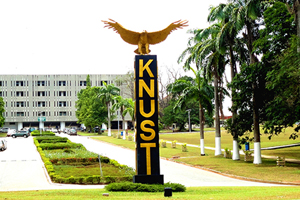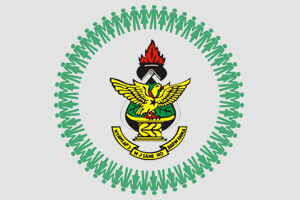Research & Innovation

Rapid, simple, inexpensive high-throughput antimicrobial susceptibility testing (AST) in natural product drug discovery and tackling antibiotic resistance in global infectious diseases.
Dr (Mrs) Cynthia Amaning Danquah
BPharm (Hons), MPhil (Pharmacology), PhD (London), MPSGH
Abstract
Current evidence of increasing failure to antimicrobial therapy due to drug resistance may be leading us potentially into a post-antibiotic era, and thus threaten the advances made in medicine (Carlet et al., 2012). The worldwide surge in resistant bacteria and the paradoxical downward trend in the development of new antibiotics simultaneously have serious implications. The reason being that resistant bacteria dramatically reduce the possibilities of treating infectious diseases effectively and multiply the risks of complications with fatal consequences for patients with infections (Maitra et al., 2015, Jasovsky et al., 2016, Maitra et al., 2017).
The World Health Organization has described antibiotic resistance as the single greatest challenge with infectious diseases today, affecting rich and poor countries alike (Piddock, 2016, Danquah et al., 2016). Globalization, with increased migration, trade and travel, has widened the range for infectious diseases (Carlet et al., 2014). The emergence of extensively-drug-resistant strains of Mycobacterium tuberculosis, antimicrobial resistance among the ESKAPE (Enterococcus faecium, Staphylococcus aureus, Klebsiella pneumoniae, Acinetobacter baumanii, Pseudomonas aeruginosa, and Enterobacter species) as well as fungal pathogens (such as certain species of Candida, Aspergillus, Cryptococcus, Trichophyton) poses a significant 21st century scientific challenge (Danquah et al., 2016).
The pipeline for new antibiotics is running dry (Laxminarayan et al., 2013, Chetty et al., 2017). There is therefore an urgent need for the discovery and development of new antibacterials with novel mechanisms of action or pleiotropic modes of action to tackle this growing and evolving menace. Natural products are a rich source of bioactive compounds historically, and plants in particular are an outstanding source of chemical scaffolds with true chemical diversity (extensive functional group chemistry and chirality) (Gibbons, 2004, Shiu et al., 2012, O'Donnell et al., 2009, Guzman et al., 2010). The choice of plants is logical given the ecological rationale that plants produce natural products or metabolites/molecules as chemical defence against microbes in their environment (Guzman et al., 2012, O'Donnell et al., 2009).
In Ghana, several plants are used traditionally as antimicrobials for wound healing and respiratory tract infections (Agyare et al., 2016, Agyare et al., 2013, Mensah et al., 2011, Mensah et al., 2006). Bioassay guided isolation and characterization of compounds from these plant extracts can help in the identification of lead molecules or compounds that can be developed as drugs.
Currently, with an extremely limited arsenal of efficacious antibiotics, techniques that can identify novel antimicrobials and detect antimicrobial resistance are becoming increasingly important (Houghton et al., 2005, Danquah et al., 2016, Evangelopoulos and Bhakta, 2010). The development of a rapid, simple and inexpensive but gold standard method to evaluate novel chemical entities for new anti-infective drug discovery as well as antimicrobial susceptibility test, to detect antibiotic resistance profile is essential for screening large quantities of plant extracts, fractions, isolated compounds as well as semi-synthetic and synthetic analogues of the compounds.
Originally developed in Dr. Bhakta’s laboratory (use web-link: http://www.bbk.ac.uk/biology/our-staff/academic/sanjib-bhakta) the High-throughput Spot-culture Growth Inhibition Assay (HT-SPOTi) is a quantitative assay principally based on the growth of an organism on semi-solid agar media containing a range of different concentrations of drugs or inhibitors. A good indicator to judge the endpoint of the experiment is when spots of microbial growth are clearly visible in the control wells containing no drugs /inhibitors after incubation; the Minimum Inhibitory Concentrations (MIC) of the novel drugs/inhibitors can then be reported (Danquah et al., 2016, Evangelopoulos and Bhakta, 2010, Gupta and Bhakta, 2012). It tackles many challenges of phenotypic evaluation of chemical entities with a number of advantages. Many of the assays currently in use are limited by the amount of compounds/inhibitors available for novel antimicrobial screening or clinical samples in the case of antimicrobial susceptibility testing. Therefore, it is advantageous to have a straight-forward and relatively inexpensive method that consumes minute quantities of drugs/inhibitors as well as diagnostic samples while providing direct and reliable information within a short period.
The simplicity of the (HT-SPOTi) method (Evangelopoulos and Bhakta, 2010, Danquah et al., 2016) makes it useful in a research laboratory as well as a clinical laboratory in resource deprived settings. As novel antimicrobial screening and drug susceptibility profiling require information on the presence or absence of microbial growth under exposure of given chemical entities, this assay can be adapted to suit both purposes. The application of this assay in AST would immensely contribute to the detection of an antibiotic resistance profile, especially in rural areas where access to sophisticated and expensive medical equipment is often limited.
Compounds from various sources such as natural products, their synthetic and semi-synthetic analogues, as well as target-based novel chemicals can all be tested using the assay (Wube et al., 2012, O'Donnell et al., 2009, Guzman et al., 2010, Osman et al., 2012). A combination of inhibitor molecules can also be tested simultaneously to determine whether there is any interaction in the form of synergism, antagonism or indifference of more than one inhibitor (Guzman et al., 2013).
The HT-SPOTi, has numerous advantages over other classical and modern whole-cell phenotypic assays, in that contamination can be easily monitored resulting in more rigorous quality control. Compounds which are hydrophobic are evenly distributed in the molten agar before it solidifies, therefore reducing the chances of aggregation or clustering which would otherwise affect the results obtained. Again, some natural products are often coloured and thus can interfere with the colorimetric read-out when using viability indicator dyes such as methyl thiazolyl tetrazolium (MTT) or resazurin/alamar blue. Additionally, some compounds such as flavonoids possess antioxidant properties, which are conjugated and can reduce the oxidized dyes used in the colorimetric assays resulting in false positives (O'Brien et al., 2000, Peng et al., 2005).
In the case of fungi, a rapid, simple and accurate susceptibility testing of dermatophytes to antifungals or other inhibitors is currently lacking (Rizi et al., 2015). The successful implementation of the SPOTi assay for the evaluation of existing drugs and/or novel inhibitors as an alternative to the disc diffusion has been demonstrated (Rizi et al., 2015) where we have adapted the method for dermatophytes (e.g. Trichophyton spp.). It offers quantitative results with unambiguous MIC values. In other words, potency comparison of various compounds is simplified, whereas with the disc diffusion method, comparisons are often hindered by the fact that the amounts used on the discs and zones of inhibition could differ depending on the physical properties of the antifungals tested and their relative diffusivity in the agar media. Furthermore, this method reduces the incubation time compared to the disc diffusion method.
It is anticipated that large quantities of natural products (medicinal plants, microbes, marine extracts and contaminated water samples, chemicals produced by insects, clinical samples) and fractions of compounds from isolation, semi-synthethic and synthethic analogues can be screened within the shortest possible time using the HT-SPOTi method.
For more details on the method read:
DANQUAH, C. A., MAITRA, A., GIBBONS, S., FAULL, J. & BHAKTA, S. 2016. HT-SPOTi: A Rapid Drug Susceptibility Test (DST) to Evaluate Antibiotic Resistance Profiles and Novel Chemicals for Anti-Infective Drug Discovery. Curr Protoc Microbiol, 40, 17 8 1-12.
RIZI, K., MURDAN, S., DANQUAH, C. A., FAULL, J. & BHAKTA, S. 2015. Development of a rapid, reliable and quantitative method--"SPOTi" for testing antifungal efficacy. J Microbiol Methods, 117, 36-40.
MAITRA, A., DANQUAH, C. A., SCOTTI, F., HOWARD, T. K., KAMIL, T. K. & BHAKTA, S. 2015. Tackling tuberculosis: Insights from an international TB Summit in London. Virulence, 6, 661-72.
MAITRA, A., KAMIL, T. K., SHAIK, M., DANQUAH, C. A., CHRZASTEK, A. & BHAKTA, S. 2017. Early diagnosis and effective treatment regimens are the keys to tackle antimicrobial resistance in tuberculosis: A report from Euroscicon's international TB Summit 2016. Virulence, 8, 1005-1024.
Contact: Dr (Mrs) Cynthia Amaning Danquah
BPharm (Hons), MPhil (Pharmacology), PhD (London), MPSGH
Department of Pharmacology
Faculty of Pharmacy and Pharmaceutical Sciences, KNUST
(+233 265458216)
Key Collaborators: Dr. Sanjib Bhakta, Birkbeck, University of London, UK
(weblink: http://www.bbk.ac.uk/biology/our-staff/academic/sanjib-bhakta)
Prof. Simon Gibbons, UCL School of Pharmacy, London, UK
KNUST Antimicrobial Resistance (AMR) Team:
Prof. Ellis Owusu-Dabo, Public Health Physician, School of Public Health, KNUST, Kumasi, Ghana
Dr. Kwame Ohene Buabeng, Clinical Pharmacologist & Head, Department of Pharmacy Practice, FPPS, KNUST, Kumasi
Dr. Alex Owusu-Ofori, Clinical Microbiologist, School of Medical Sciences/Komfo Anokye Teaching Hospital, KNUST, Kumasi
Dr. Thomas Agyarko-Poku, Venerologist & Infectious Disease Specialist, Suntreso Government Hospital, Ghana Health Service
Dr. Geeta Hitch, Lecturer in Pharmacy Practice with research interest in AMR, University of Sussex, UK
Dr. Mrs. Cynthia Amaning Danquah, Pharmacologist, Department of Pharmacology, FPPS, KNUST, Kumasi.
References:
AGYARE, C., BOAKYE, Y. D., BEKOE, E. O., HENSEL, A., DAPAAH, S. O. & APPIAH, T. 2016. Review: African medicinal plants with wound healing properties. J Ethnopharmacol, 177, 85-100.
AGYARE, C., DWOBENG, A. S., AGYEPONG, N., BOAKYE, Y. D., MENSAH, K. B., AYANDE, P. G. & ADARKWA-YIADOM, M. 2013. Antimicrobial, Antioxidant, and Wound Healing Properties of Kigelia africana (Lam.) Beneth. and Strophanthus hispidus DC. Adv Pharmacol Sci, 2013, 692613.
CARLET, J., JARLIER, V., HARBARTH, S., VOSS, A., GOOSSENS, H., PITTET, D. & PARTICIPANTS OF THE 3RD WORLD HEALTHCARE-ASSOCIATED INFECTIONS, F. 2012. Ready for a world without antibiotics? The Pensieres Antibiotic Resistance Call to Action. Antimicrob Resist Infect Control, 1, 11.
CARLET, J., PULCINI, C. & PIDDOCK, L. J. 2014. Antibiotic resistance: a geopolitical issue. Clin Microbiol Infect, 20, 949-53.
CHETTY, S., RAMESH, M., SINGH-PILLAY, A. & SOLIMAN, M. E. 2017. Recent advancements in the development of anti-tuberculosis drugs. Bioorg Med Chem Lett, 27, 370-386.
DANQUAH, C. A., MAITRA, A., GIBBONS, S., FAULL, J. & BHAKTA, S. 2016. HT-SPOTi: A Rapid Drug Susceptibility Test (DST) to Evaluate Antibiotic Resistance Profiles and Novel Chemicals for Anti-Infective Drug Discovery. Curr Protoc Microbiol, 40, 17 8 1-12.
EVANGELOPOULOS, D. & BHAKTA, S. 2010. Rapid methods for testing inhibitors of mycobacterial growth. Methods Mol Biol, 642, 193-201.
GIBBONS, S. 2004. Anti-staphylococcal plant natural products. Nat Prod Rep, 21, 263-77.
GUPTA, A. & BHAKTA, S. 2012. An integrated surrogate model for screening of drugs against Mycobacterium tuberculosis. J Antimicrob Chemother, 67, 1380-91.
GUZMAN, J. D., EVANGELOPOULOS, D., GUPTA, A., BIRCHALL, K., MWAIGWISYA, S., SAXTY, B., MCHUGH, T. D., GIBBONS, S., MALKINSON, J. & BHAKTA, S. 2013. Antitubercular specific activity of ibuprofen and the other 2-arylpropanoic acids using the HT-SPOTi whole-cell phenotypic assay. BMJ Open, 3.
GUZMAN, J. D., GUPTA, A., BUCAR, F., GIBBONS, S. & BHAKTA, S. 2012. Antimycobacterials from natural sources: ancient times, antibiotic era and novel scaffolds. Front Biosci (Landmark Ed), 17, 1861-81.
GUZMAN, J. D., GUPTA, A., EVANGELOPOULOS, D., BASAVANNACHARYA, C., PABON, L. C., PLAZAS, E. A., MUNOZ, D. R., DELGADO, W. A., CUCA, L. E., RIBON, W., GIBBONS, S. & BHAKTA, S. 2010. Anti-tubercular screening of natural products from Colombian plants: 3-methoxynordomesticine, an inhibitor of MurE ligase of Mycobacterium tuberculosis. J Antimicrob Chemother, 65, 2101-7.
HOUGHTON, P. J., HYLANDS, P. J., MENSAH, A. Y., HENSEL, A. & DETERS, A. M. 2005. In vitro tests and ethnopharmacological investigations: wound healing as an example. J Ethnopharmacol, 100, 100-7.
JASOVSKY, D., LITTMANN, J., ZORZET, A. & CARS, O. 2016. Antimicrobial resistance-a threat to the world's sustainable development. Ups J Med Sci, 121, 159-64.
LAXMINARAYAN, R., DUSE, A., WATTAL, C., ZAIDI, A. K., WERTHEIM, H. F., SUMPRADIT, N., VLIEGHE, E., HARA, G. L., GOULD, I. M., GOOSSENS, H., GREKO, C., SO, A. D., BIGDELI, M., TOMSON, G., WOODHOUSE, W., OMBAKA, E., PERALTA, A. Q., QAMAR, F. N., MIR, F., KARIUKI, S., BHUTTA, Z. A., COATES, A., BERGSTROM, R., WRIGHT, G. D., BROWN, E. D. & CARS, O. 2013. Antibiotic resistance-the need for global solutions. Lancet Infect Dis, 13, 1057-98.
MAITRA, A., DANQUAH, C. A., SCOTTI, F., HOWARD, T. K., KAMIL, T. K. & BHAKTA, S. 2015. Tackling tuberculosis: Insights from an international TB Summit in London. Virulence, 6, 661-72.
MAITRA, A., KAMIL, T. K., SHAIK, M., DANQUAH, C. A., CHRZASTEK, A. & BHAKTA, S. 2017. Early diagnosis and effective treatment regimens are the keys to tackle antimicrobial resistance in tuberculosis (TB): A report from Euroscicon's international TB Summit 2016. Virulence, 8, 1005-1024.
MENSAH, A. Y., DONKOR, P. O. & FLEISCHER, T. C. 2011. Anti-inflammatory and antioxidant activities of the leaves of Wissadula amplissima var Rostrata. Afr J Tradit Complement Altern Med, 8, 185-95.
MENSAH, A. Y., HOUGHTON, P. J., DICKSON, R. A., FLEISCHER, T. C., HEINRICH, M. & BREMNER, P. 2006. In vitro evaluation of effects of two Ghanaian plants relevant to wound healing. Phytother Res, 20, 941-4.
O'BRIEN, N. M., WOODS, J. A., AHERNE, S. A. & O'CALLAGHAN, Y. C. 2000. Cytotoxicity, genotoxicity and oxidative reactions in cell-culture models: modulatory effects of phytochemicals. Biochem Soc Trans, 28, 22-6.
O'DONNELL, G., POESCHL, R., ZIMHONY, O., GUNARATNAM, M., MOREIRA, J. B., NEIDLE, S., EVANGELOPOULOS, D., BHAKTA, S., MALKINSON, J. P., BOSHOFF, H. I., LENAERTS, A. & GIBBONS, S. 2009. Bioactive pyridine-N-oxide disulfides from Allium stipitatum. J Nat Prod, 72, 360-5.
OSMAN, K., EVANGELOPOULOS, D., BASAVANNACHARYA, C., GUPTA, A., MCHUGH, T. D., BHAKTA, S. & GIBBONS, S. 2012. An antibacterial from Hypericum acmosepalum inhibits ATP-dependent MurE ligase from Mycobacterium tuberculosis. Int J Antimicrob Agents, 39, 124-9.
PENG, L., WANG, B. & REN, P. 2005. Reduction of MTT by flavonoids in the absence of cells. Colloids Surf B Biointerfaces, 45, 108-11.
PIDDOCK, L. J. V. 2016. Reflecting on the final report of the O'Neill Review on Antimicrobial Resistance. Lancet Infect Dis, 16, 767-768.
RIZI, K., MURDAN, S., DANQUAH, C. A., FAULL, J. & BHAKTA, S. 2015. Development of a rapid, reliable and quantitative method--"SPOTi" for testing antifungal efficacy. J Microbiol Methods, 117, 36-40.
SHIU, W. K., RAHMAN, M. M., CURRY, J., STAPLETON, P., ZLOH, M., MALKINSON, J. P. & GIBBONS, S. 2012. Antibacterial acylphloroglucinols from Hypericum olympicum. J Nat Prod, 75, 336-43.
WUBE, A., GUZMAN, J. D., HUFNER, A., HOCHFELLNER, C., BLUNDER, M., BAUER, R., GIBBONS, S., BHAKTA, S. & BUCAR, F. 2012. Synthesis and antibacterial evaluation of a new series of N-Alkyl-2-alkynyl/(E)-alkenyl-4-(1H)-quinolones. Molecules, 17, 8217-40.







